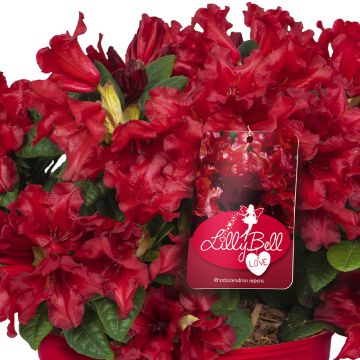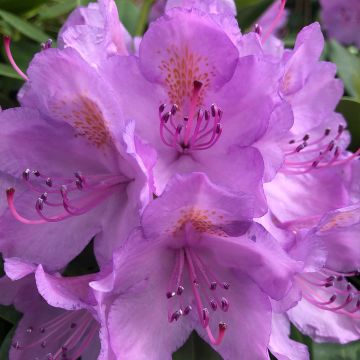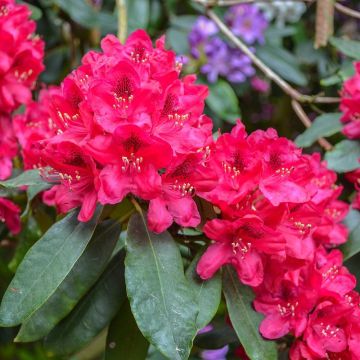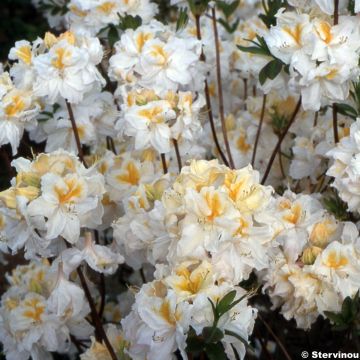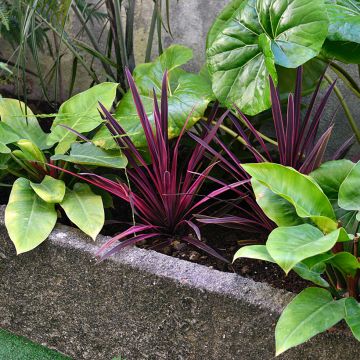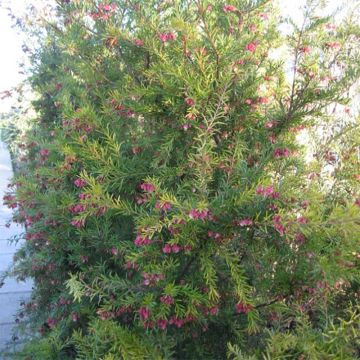

Rhododendron Alfred


Rhododendron Alfred


Rhododendron Alfred
Rhododendron Alfred
Rhododendron Alfred
Rhododendron
This item cannot be shipped to the selected country
Delivery charge from €5.90
More information
Schedule delivery date,
and select date in basket
This plant carries a 24 months recovery warranty
More information
We guarantee the quality of our plants for a full growing cycle, and will replace at our expense any plant that fails to recover under normal climatic and planting conditions.
From €5.90 for pickup delivery and €6.90 for home delivery
Express home delivery from €8.90.
Does this plant fit my garden?
Set up your Plantfit profile →
Description
Rhododendron 'Alfred' is a variety that is over a hundred years old, but has lost none of its interest. It has beautiful flowering in spring, with each flower illuminated with mauve and white at its core, pleasantly romantic. Its beautiful dark green evergreen foliage highlights this flowering well. A heath plant, it appreciates acidic soils and is sensitive to limestone. It prefers partial shade, but depending on the climate, it can be planted in the sun in colder regions, provided the soil does not dry out.
Rhododendrons belong to the Ericaceae family, which supplies us with numerous ornamental plants (Erica, Enkianthus, Kalmia, Zenobia, Oxydendrum...) as well as some fruit plants (Arbutus, Blueberry...). The Rhododendron genus is extremely vast, mainly comprising of bushes, but also trees over 10m (33ft) tall, generally evergreen, but sometimes deciduous, particularly in the case of Azaleas, which are actually botanically speaking Rhododendrons.
Rhododendron Alfred is a very old hybrid, as it was obtained in 1891 by T.J.Rudolf Seidel in Germany, near Dresden. The Seidel nursery is still active in Grüngräbchen, a village in northern Saxony. It matures into a bush 1.60 to 1.80m (5 to 6ft) in height and 1.80 to 2m (6 to 7ft) wide, adorned with beautiful dark green evergreen foliage. It is obviously its flowering that attracts attention around mid-May to June. Beautiful mauve flowers, which lighten to become almost white at their centre, are produced in clusters at the end of the branches.
Rhododendron Alfred, a heath plant, is ideally suited to acidic or peaty soils, and will therefore thrive in partial shade in a fresh, humus-rich and well-drained soil with an acidic pH. It is hardy in most regions, but will only reach its full potential in a wet and not too hot climate. It can be used as a specimen plant or in mass plantings, especially with other heath plants. You can associate it with many other flowering species, and by choosing staggered flowering times, you can enjoy it all year round! Witch Hazels will open the show with their delicate yellow, orange or red spider-like flowers in the middle of winter. The unmissable Camellias will follow suit at the end of winter, with their magnificent single or double flowers, available in a wide range of colours. Then our little Rhododendron and many of its counterparts will transform spring into a fireworks display of colours. In May-June, superb Kalmias will take the stage, before passing the baton to the Hydrangeas to bloom in summer. Summer heaths, like the vibrant Calluna vulgaris 'Bonita', will keep the fire burning until late in the season, before handing over to the varieties of Camellia sasanqua, the autumn Camellia, which actually blooms more in winter.
Report an error about the product description
Rhododendron Alfred in pictures


Plant habit
Flowering
Foliage
Botanical data
Rhododendron
Alfred
Ericaceae
Rhododendron
Cultivar or hybrid
Other Rhododendron and Azalea A to Z
Planting and care
Plant Rhododendron 'Alfred' in a semi-shaded position, protected from cold and drying winds, in a damp, humus-rich, and light soil with an acidic tendency. Like all plants in the heath family, it does not tolerate limestone soils or heavy soils saturated with water in winter. Dig a hole three times larger than the pot. Soak the root ball in non-calcareous water and plant the shrub at the level of the collar, in a mixture composed of 1/4 compost, humus, gravel or pumice, and loam. Water generously and keep the soil moist in summer.
Azaleas and Rhododendrons have a shallow and relatively limited root system. Therefore, they are sensitive to long periods of drought. That is why it is recommended to enrich the soil with humus beforehand and water abundantly with non-calcareous water during dry periods. In addition, this root system is not very strong, which is why it is essential to lighten heavy soils with draining materials (gravel, pumice, clay pellets) when planting. Apply a mulch of shredded pine bark around the base of the bush every spring to maintain soil moisture while keeping an acidic pH.
Maintenance involves removing old faded flowers in summer using pruning shears and clearing the plant of dead branches. Azaleas and Rhododendrons can sometimes be attacked by weevils that eat the edges of leaves and rootlets, as well as the infamous "rhododendron beetle" which does not often cause significant damage. Yellowing of the leaves (chlorosis) in Rhododendrons indicates poor iron assimilation in the soil and can lead to the premature death of the plant. While limestone is generally the cause, poorly-drained soil or deeply planted root balls can also explain the phenomenon.
Planting period
Intended location
Care
This item has not been reviewed yet - be the first to leave a review about it.
Evergreen shrubs
Haven't found what you were looking for?
Hardiness is the lowest winter temperature a plant can endure without suffering serious damage or even dying. However, hardiness is affected by location (a sheltered area, such as a patio), protection (winter cover) and soil type (hardiness is improved by well-drained soil).

Photo Sharing Terms & Conditions
In order to encourage gardeners to interact and share their experiences, Promesse de fleurs offers various media enabling content to be uploaded onto its Site - in particular via the ‘Photo sharing’ module.
The User agrees to refrain from:
- Posting any content that is illegal, prejudicial, insulting, racist, inciteful to hatred, revisionist, contrary to public decency, that infringes on privacy or on the privacy rights of third parties, in particular the publicity rights of persons and goods, intellectual property rights, or the right to privacy.
- Submitting content on behalf of a third party;
- Impersonate the identity of a third party and/or publish any personal information about a third party;
In general, the User undertakes to refrain from any unethical behaviour.
All Content (in particular text, comments, files, images, photos, videos, creative works, etc.), which may be subject to property or intellectual property rights, image or other private rights, shall remain the property of the User, subject to the limited rights granted by the terms of the licence granted by Promesse de fleurs as stated below. Users are at liberty to publish or not to publish such Content on the Site, notably via the ‘Photo Sharing’ facility, and accept that this Content shall be made public and freely accessible, notably on the Internet.
Users further acknowledge, undertake to have ,and guarantee that they hold all necessary rights and permissions to publish such material on the Site, in particular with regard to the legislation in force pertaining to any privacy, property, intellectual property, image, or contractual rights, or rights of any other nature. By publishing such Content on the Site, Users acknowledge accepting full liability as publishers of the Content within the meaning of the law, and grant Promesse de fleurs, free of charge, an inclusive, worldwide licence for the said Content for the entire duration of its publication, including all reproduction, representation, up/downloading, displaying, performing, transmission, and storage rights.
Users also grant permission for their name to be linked to the Content and accept that this link may not always be made available.
By engaging in posting material, Users consent to their Content becoming automatically accessible on the Internet, in particular on other sites and/or blogs and/or web pages of the Promesse de fleurs site, including in particular social pages and the Promesse de fleurs catalogue.
Users may secure the removal of entrusted content free of charge by issuing a simple request via our contact form.
The flowering period indicated on our website applies to countries and regions located in USDA zone 8 (France, the United Kingdom, Ireland, the Netherlands, etc.)
It will vary according to where you live:
- In zones 9 to 10 (Italy, Spain, Greece, etc.), flowering will occur about 2 to 4 weeks earlier.
- In zones 6 to 7 (Germany, Poland, Slovenia, and lower mountainous regions), flowering will be delayed by 2 to 3 weeks.
- In zone 5 (Central Europe, Scandinavia), blooming will be delayed by 3 to 5 weeks.
In temperate climates, pruning of spring-flowering shrubs (forsythia, spireas, etc.) should be done just after flowering.
Pruning of summer-flowering shrubs (Indian Lilac, Perovskia, etc.) can be done in winter or spring.
In cold regions as well as with frost-sensitive plants, avoid pruning too early when severe frosts may still occur.
The planting period indicated on our website applies to countries and regions located in USDA zone 8 (France, United Kingdom, Ireland, Netherlands).
It will vary according to where you live:
- In Mediterranean zones (Marseille, Madrid, Milan, etc.), autumn and winter are the best planting periods.
- In continental zones (Strasbourg, Munich, Vienna, etc.), delay planting by 2 to 3 weeks in spring and bring it forward by 2 to 4 weeks in autumn.
- In mountainous regions (the Alps, Pyrenees, Carpathians, etc.), it is best to plant in late spring (May-June) or late summer (August-September).
The harvesting period indicated on our website applies to countries and regions in USDA zone 8 (France, England, Ireland, the Netherlands).
In colder areas (Scandinavia, Poland, Austria...) fruit and vegetable harvests are likely to be delayed by 3-4 weeks.
In warmer areas (Italy, Spain, Greece, etc.), harvesting will probably take place earlier, depending on weather conditions.
The sowing periods indicated on our website apply to countries and regions within USDA Zone 8 (France, UK, Ireland, Netherlands).
In colder areas (Scandinavia, Poland, Austria...), delay any outdoor sowing by 3-4 weeks, or sow under glass.
In warmer climes (Italy, Spain, Greece, etc.), bring outdoor sowing forward by a few weeks.



































